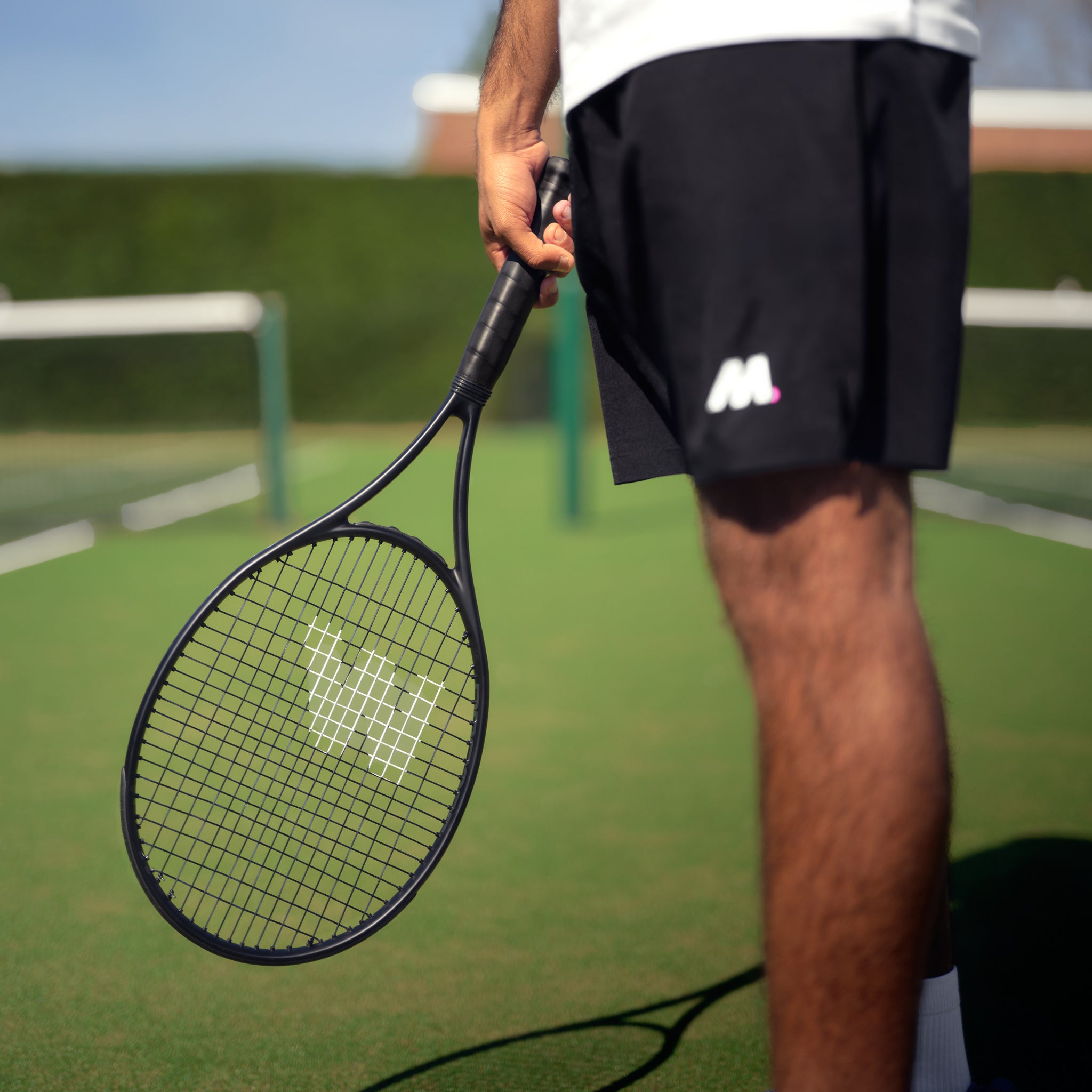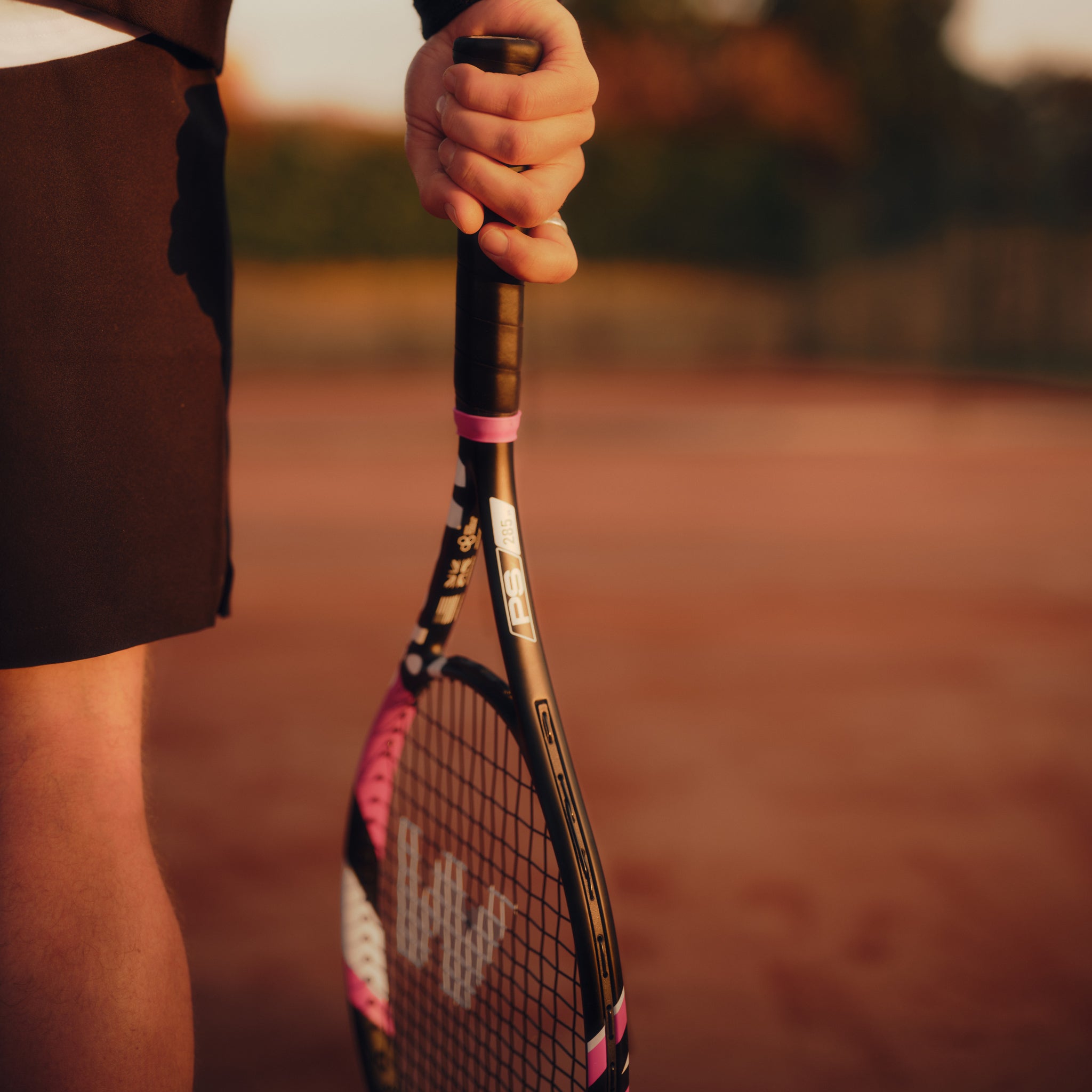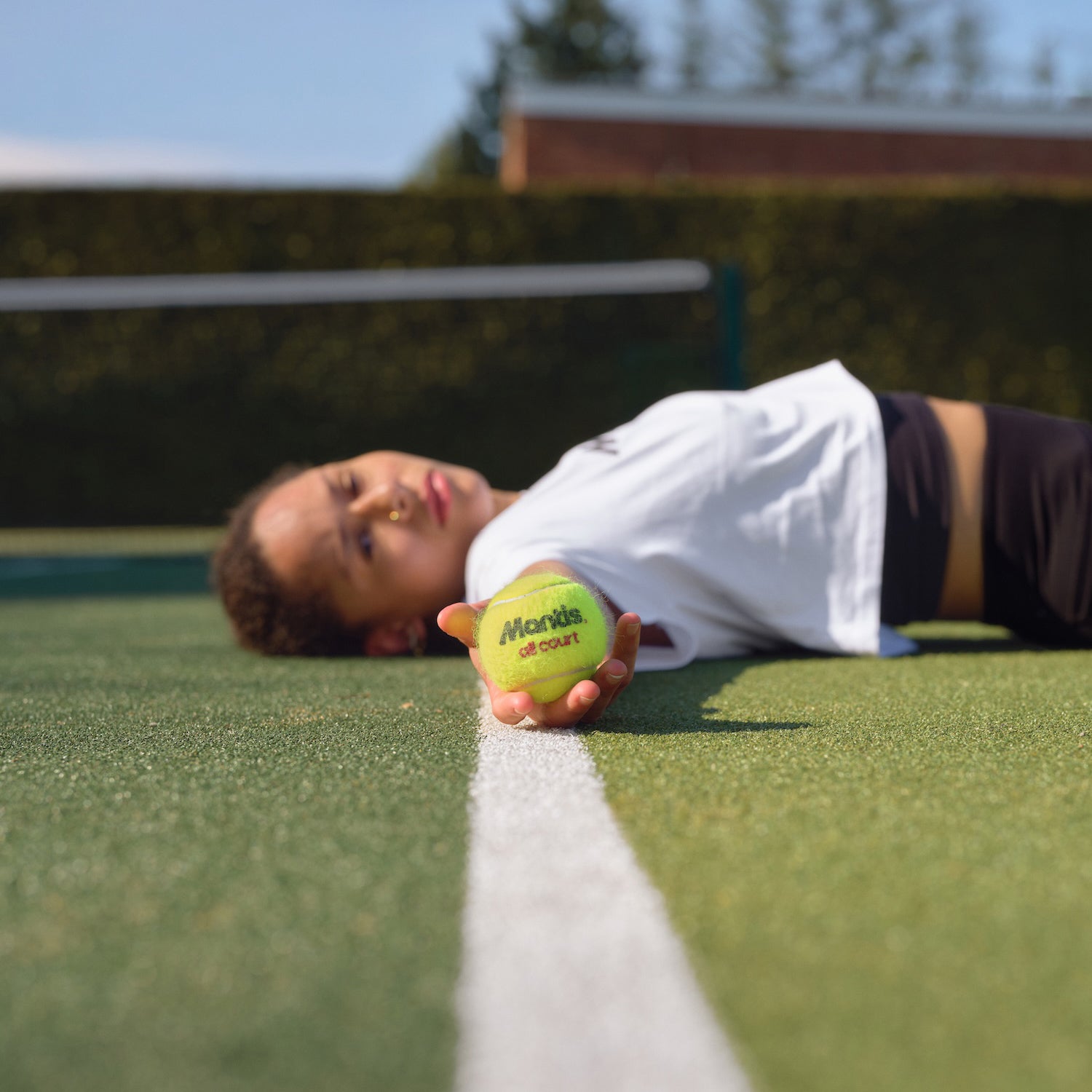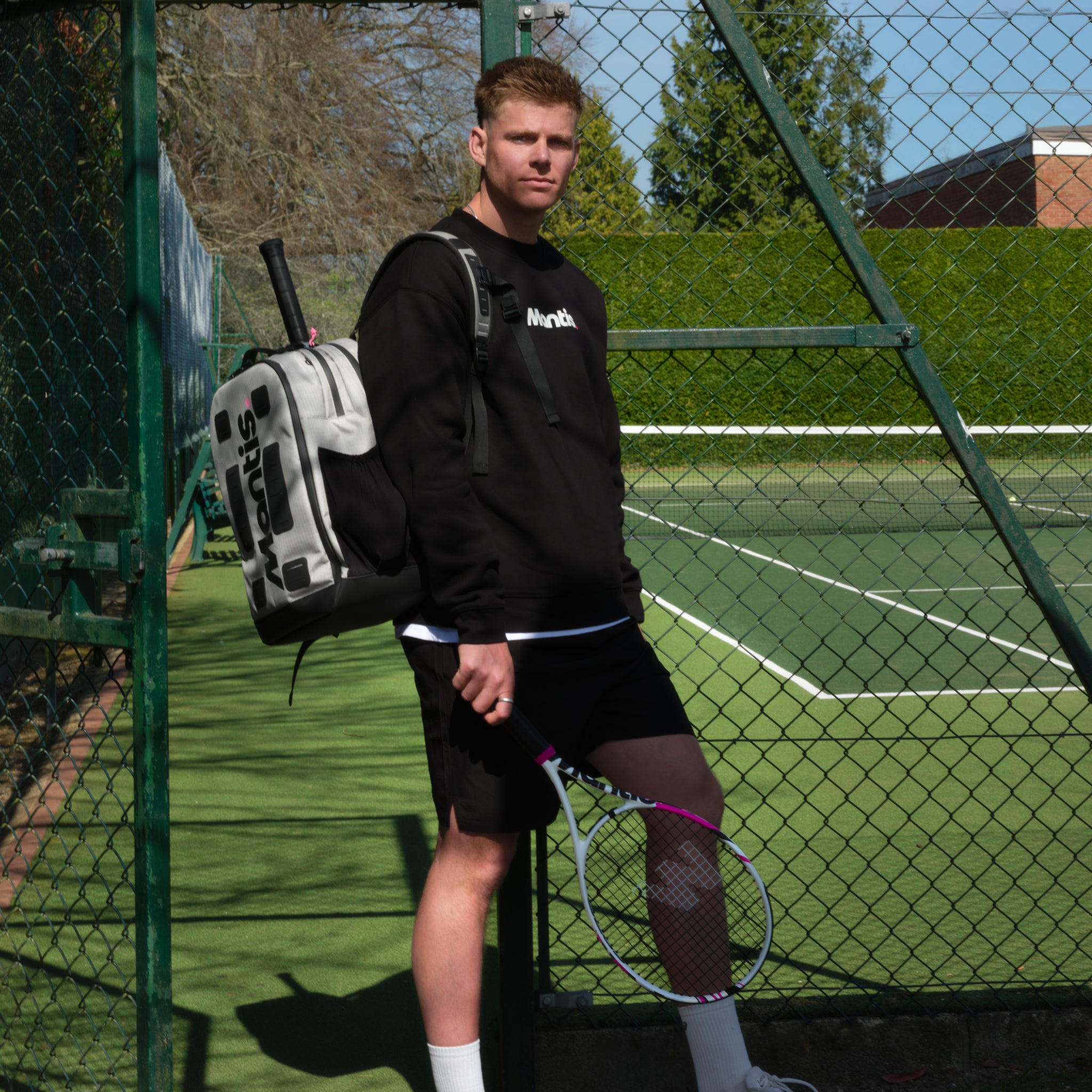
To be an effective tennis coach, you need a powerful mix of technical know-how, sports science insight, and a knack for adaptive teaching. The role today is about so much more than just understanding strokes and strategy; it's about inspiring players, analysing their game, and developing them as a whole whichcyou will learn more about in this modern guide to coaching tennis.
At Mantis, we're here to support both players and aspiring coaches with insights and top-quality equipment, bolstering the fantastic community of UK tennis coaches and clubs.
You can find out how Mantis supports coaches and clubs right here: https://mantissport.com/pages/tennis-coaches-and-clubs
A Modern Guide to Coaching Tennis
To really get to grips with what it means to be a successful tennis coach in the UK today, it helps to understand how we got here. The profession has come a long way, transforming from a loose, informal role into a respected, structured, and science-driven career. Knowing this history gives you a real appreciation for the high standards and sophisticated techniques that define elite coaching now.
It wasn't always such a clear-cut path. Back in the late 19th and early 20th centuries, professional coaches were often phenomenal players in their own right but found themselves up against significant social and professional hurdles.
People like Tom Burke and Harry Cowdrey were considered just as talented as the top amateur players of their day. Yet, the rigid class and amateurism rules in British tennis meant they were labelled "professionals," often pushing them to the margins of the sport's formal world.
From Sidelined Professional to Respected Mentor
Fast forward to today, and the tennis coach is a central, respected figure in any player's journey. This change is part of a wider professionalisation of the sport, championed by governing bodies like the Lawn Tennis Association (LTA), which has helped shape coaching into the multi-disciplinary role it is now.
A modern coach is expected to wear many hats beyond just being a technical instructor. The role has expanded to include:
- Sports Science: Using biomechanics, physiology, and nutrition to boost performance and keep players injury-free.
- Psychology: Building a player's mental toughness, helping them stay focused and think strategically under pressure.
- Mentorship: Acting as a guide through an athlete's career, offering support both on and off the court.
- Business Acumen: Juggling schedules, managing finances, and marketing to build a successful coaching business.
The best coaches we know are lifelong learners. They’re always adapting to new research, using technology to their advantage, and refining their methods. Success isn’t just about teaching a great forehand anymore; it’s about building a complete, well-rounded athlete.
The Entrepreneurial Spirit of Modern Coaching
Being a great coach today often means being a bit of an entrepreneur. Many coaches are essentially running their own small businesses, which demands a completely different set of skills to what you need on the court.
If you're just starting out, getting your head around the business side of things is absolutely crucial. This entrepreneurial drive is what allows coaches to create their own specialised programmes, build a personal brand, and push the sport forward in new and exciting ways.
Navigating the LTA Coaching Pathway
Here at Mantis, we know that understanding this structured pathway is the first real step toward building a credible and lasting coaching career. It’s not just a set of hoops to jump through; it's a clear progression that ensures you're properly equipped to help players at every stage, from their first forehand to competitive match play.
The whole system is designed to build your skills piece by piece. Starting with the basics, you gradually move up from an assistant to a lead coach and potentially even to the elite level. Getting your Level 3 qualification is a key milestone, as it’s the one that lets you work full-time with beginners and improvers, coaching both groups and individuals on your own.
It’s all about that cycle: evaluating where a player is, creating a tailored plan to help them improve, and then consistently measuring their progress to refine the next steps.
Your Starting Point: Levels 1 and 2
Every coaching career starts with the LTA Level 1 Tennis Assistant qualification. Think of this as your essential entry ticket. It qualifies you to assist a more senior coach (Level 3 or higher) during group sessions. The real focus here is learning the fundamentals: keeping everyone safe, organising the court effectively, and communicating clearly.
Once you’ve got the hang of that, the LTA Level 2 Coaching Assistant qualification is the logical next step. This is where you get to take on a bit more responsibility, leading small group sessions while still under the watchful eye of a head coach. You'll start learning more about session planning and the finer points of coaching technique. It's a crucial stepping stone that gives you a real taste of leading from the front.
A solid foundation at Levels 1 and 2 is about so much more than just running drills. It’s where you truly learn to manage groups, inspire young players, and build the kind of trust that underpins every great coaching relationship.
Earning Your Independence: Level 3
This is the big one. The LTA Level 3 Coach qualification is where you officially transition from an assistant to a fully independent coach. Once you have this, you can plan and deliver your own group and individual lessons without supervision.
A Level 3 coach is the lifeblood of grassroots tennis, working with beginners and club-level improvers. To get here, you need to prove you have a firm grip on:
- Technical analysis and how to correct all the major strokes.
- Tactical development suitable for club and recreational players.
- The business basics needed to run your own coaching service.
This qualification unlocks full-time coaching roles at clubs, parks, and schools, turning a passion into a proper career. Your earning potential also gets a significant boost, reflecting your enhanced skills and responsibility.
The Route to Elite Performance: Levels 4 and 5
For coaches who dream of working with top-tier talent, the journey doesn't stop at Level 3. The LTA Level 4 Senior Performance Coach qualification is your next challenge, preparing you to develop aspiring junior and adult competitors. The learning here gets much more advanced, diving deep into sports science, performance analysis, and planning for long-term athlete development.
At the very top of the pyramid is the LTA Level 5 Master Performance Coach qualification. This is reserved for the absolute elite—the coaches who guide national and international players. It represents the highest standard of coaching in the UK, demanding a sophisticated approach that blends psychology, biomechanics, and strategic career management to create world-class athletes. Getting to this level takes immense dedication and a proven track record of developing top talent.
To make this pathway clearer, here’s a simple breakdown of the different LTA coaching qualifications and who they're designed for.
LTA Tennis Coaching Qualification Pathway
| Qualification Level | Primary Role | Target Player Group |
|---|---|---|
| Level 1 Tennis Assistant | Assists a qualified coach | Beginners in group settings |
| Level 2 Coaching Assistant | Leads supervised group sessions | Beginners and early improvers |
| Level 3 Coach | Independent Head/Lead Coach | Club-level improvers, beginners, juniors |
| Level 4 Senior Performance Coach | Performance Development Coach | Aspiring junior and adult competitors |
| Level 5 Master Performance Coach | Elite National/International Coach | Professional and high-performance athletes |
As you can see, the LTA has created a logical and progressive structure that supports a coach's development from their very first on-court session right through to the highest levels of the sport.
Designing High-Impact Coaching Sessions
A truly effective tennis coaching session is far more than just an hour of hitting balls. It’s a carefully crafted journey with a clear beginning, middle, and end, all designed to make a real difference. Here at Mantis, we believe every moment on court is an opportunity for targeted improvement, and a well-structured plan is what separates a good coach from a great one. For those looking to elevate their coaching, we’re proud to be a key partner for tennis coaches and clubs across the UK.
So, what’s the secret sauce? It starts with being deliberate about how you use your time. You can’t teach everything in one go. In fact, trying to do so often leads to players feeling overwhelmed. The best approach we've found over the years follows a simple, four-phase blueprint that guides a player from warm-up to match-ready performance.
The Dynamic Warm-Up Phase
Forget static stretches. The first 10-15 minutes of any session should be all about getting the body primed for what’s to come. We’re talking about a dynamic warm-up that gets blood flowing, loosens up the joints, and starts to activate the specific movement patterns used in tennis. It’s about preparation, not exhaustion.
A good warm-up has a natural flow, moving from general to tennis-specific actions:
- Get Moving: Start with light jogging, side shuffles, or carioca to gently raise the heart rate.
- Activate the Muscles: Then, move into dynamic stretches. Think leg swings (forwards and sideways), torso twists, and big arm circles to get the key muscle groups firing.
- Feel the Ball: Finally, bring it into mini-tennis on the service boxes. This is brilliant for getting players to focus on soft hands and controlled footwork before they move back to the baseline.
With younger players, we often turn this into a game using agility ladders or reaction balls. It keeps them laughing and engaged while they get their bodies ready for the real work.
The Technical and Tactical Focus
This is the heart of the session. For the next 30-40 minutes, you need to zoom in on one specific area of improvement. We can't stress this enough: trying to fix a player's forehand, backhand, and serve all in one lesson is a recipe for disaster. Pick one thing and do it well. Maybe it's improving the consistency of the service toss, or perhaps it's developing a reliable cross-court backhand.
You'll want to begin with controlled, repetitive drills where the player can really isolate the technique. For instance, if you're working on a forehand approach shot, start with some simple basket feeds. This takes the pressure of a live rally out of the equation, allowing them to focus entirely on their footwork and finding the right contact point.
The real magic happens when you connect a technical skill to a tactical situation. A coach might say, "We're working on hitting the forehand down the line, because that's your go-to shot when you've pulled your opponent wide with a cross-court rally." This gives the drill purpose.
Once they've got the feel for it in a closed drill, you can gradually introduce more open, game-like scenarios. It's all about building that muscle memory and then immediately applying it in a context that feels like a real match.
The Competitive Application Phase
Now it’s time to dial up the intensity. The next 15-20 minutes should be all about simulating the pressure of a real match. This is where you test the skills you've just worked on, bridging that crucial gap between knowing how to hit a shot and knowing when to use it.
A few of our favourite drills for this phase include:
- Conditional Point Play: Play out points where the player must use the target shot to have a chance of winning. For example, every point has to be finished with a volley.
- King of the Court: A classic for a reason. It's a fast-paced game where a challenger tries to take the "king's" spot by winning a single point. It's fantastic for practising high-stakes serves and returns.
These drills force players to think on their feet and execute when they're a bit tired. That's what builds mental toughness and helps them make smarter decisions when the match is on the line.
The Cool-Down and Feedback Loop
Don't let your players just pack up and leave. The final 5-10 minutes are just as important as the first. A proper cool-down, with some light jogging and static stretching (holding each stretch for 20-30 seconds), is essential for kicking off the recovery process and reducing muscle soreness.
This is also your golden opportunity to provide clear, concise feedback. Quickly recap the main goal of the session and highlight one or two things they did really well. Ending on a positive, encouraging note with a specific takeaway gives them something to think about and builds their confidence for the next time they step on court.
Core Drills Every Tennis Coach Needs
Any good coach has a deep well of drills to draw from, but the great ones know why they’re choosing a specific drill for a specific player at a specific time. At Mantis, we partner with a fantastic network of tennis coaches and clubs who get this. They understand that a great drill isn’t just about hitting a thousand balls; it’s about isolating a skill, embedding a tactic, and building a player’s self-belief when the pressure is on.
Think of drills as the backbone of player development. They give you the reps needed to make great technique second nature and create structured scenarios to sharpen those all-important match-play instincts. The golden rule is purpose. Every minute your player spends on the court needs to count.
Building Rock-Solid Consistency
Before we can even talk about fancy tactics or killer shots, a player has to be able to keep the ball in play. Consistency is the bedrock of a solid tennis game. These drills are all about finding rhythm, gaining control, and building the stamina to do it point after point.
A simple classic we always come back to is the Cross-Court Rally Challenge. Two players just rally diagonally, aiming for a set number of consecutive shots—say, 20 balls—without missing. It’s brilliant for training focus, footwork, and depth control all at once.
Once they've mastered that, you can level it up. Drop a few targets in the corners. Now, they aren’t just rallying; they're aiming for precise spots while maintaining that same consistency. That’s how you start building points.
Another go-to is the "Figure 8". You feed balls, alternating between their forehand and backhand corners. The player is forced to move laterally and, crucially, recover to the centre after every single shot. It’s a fantastic drill for building both consistency and court coverage.
Sharpening Footwork and Movement
The modern game is all about movement. We've seen it a thousand times: a player with average strokes but phenomenal footwork will often dismantle someone with beautiful shots but sluggish feet. That ability to slam on the brakes and explode in a new direction—what we call COD (change-of-direction)—is everything.
The "Spider Drill" is a classic for a good reason. You place five balls on the court—one on each corner of the service box and one at the centre 'T'. The player starts on the baseline, sprints to touch each ball with their racket, and gets back to the start. It’s a killer workout for developing multi-directional speed.
For something a bit more tennis-specific, we love the "Recovery Box" drill. A coach will feed a wide ball that forces the player to hit on the run. Their job isn't just to make the shot; it’s to hustle back to a designated "recovery box" in the middle of the court before the next ball comes.
This drill ingrains the habit of seeing recovery as part of the shot itself. That’s a mindset that separates the good players from the truly great ones.
The real goal of footwork drills isn't just about raw speed. It's about efficiency—arriving at the ball balanced, with enough time to hit a controlled, effective shot. That takes anticipation, an explosive first step, and disciplined recovery.
Mastering the Serve and Return
These are the two shots that start every single point. They're non-negotiable. Any coaching programme worth its salt has to dedicate serious time here. We need to focus on placement, variety, and the ability to execute under pressure.
For the serve, you can't beat "Target Practice". Place some cones in the three key spots: wide, body, and down the T. Give the server a full basket of balls and tell them they have to knock over each target a certain number of times. This builds massive confidence and directly translates to hitting your spots in a match.
When it comes to the return, a great one is the "Chip and Charge". The coach will hit a medium-paced serve, and the player’s job is to hit a deep, controlled return—often a slice or a block—and immediately follow it to the net. It's a perfect way to practise breaking serve by taking time away from the opponent and applying instant pressure.
High-Pressure Point Simulation
All the technical skill in the world doesn't mean much if it crumbles under match pressure. Simulating that stress in training is where players learn to make smart decisions when they're tired or nervous.
One of our favourites is "First to Five." Two players play points, but with a handicap. One player starts every single game at 30-0, while the other starts at 0-30. This instantly creates a high-stakes feel where every point is massive. It’s a brilliant way to train players to handle both leading and trailing.
Another powerful one is the "Situational Scramble." The coach will start the point by feeding a really awkward ball—maybe a deep defensive lob or a short, sharp slice—that puts one player on the back foot from the get-go. Their task is to neutralise the point and find a way back into an offensive position.
This drill is all about resilience and problem-solving. It teaches the crucial lesson that not every point will start on your own terms. Weaving these drills into your plan creates a well-rounded player who has the consistency, movement, and mental grit to win matches.
Integrating Modern Coaching Technology
The way we coach tennis is definitely changing, and technology is right at the centre of it all. At Mantis, we're seeing first-hand how modern tools are shifting the focus from broad, one-size-fits-all instruction to a much sharper, player-centric approach.
Make no mistake, this isn't about replacing core coaching skills—it's about amplifying them. To get a better sense of how digital tools are already shaping the game, take a look at our guide on the benefits of online tennis instruction.
The days of purely discipline-focused training are fading fast. Here in the UK, coaching has moved towards highly individualised, science-based programmes. Coaches now lean on sports science, psychology, and a whole host of tech—AI, video analysis, and wearables—to tailor training to a player's exact needs.
This shift gives coaches the power to make decisions based on hard data, not just intuition alone. The result? A more precise and effective path for player development.
Harnessing the Power of Video Analysis
If there’s one piece of tech that every coach should have in their toolkit, it’s video. What used to demand expensive, clunky equipment is now in the palm of your hand with a smartphone or tablet. It provides immediate, visual feedback that words alone often struggle to convey.
The real magic is in its immediacy. You can film a player's serve, hit pause, and instantly show them the subtle flaw in their ball toss or a slight delay in their hip rotation. This instant feedback loop is a game-changer. It dramatically speeds up learning because the player sees exactly what you mean while the muscle memory is still fresh.
Want to go deeper? Apps that offer slow-motion playback and side-by-side comparisons with pros are fantastic for helping players visualise the ideal technique and truly understand the small adjustments they need to make.
Leveraging Data with Performance Tracking Apps
Beyond simple video playback, a new wave of AI-powered apps is giving coaches incredible insight into a player’s game. These tools can track everything from shot patterns and rally lengths to shot speed, turning a standard hitting session into a goldmine of performance data.
Imagine this: after a practice match, you pull up a heat map of your player’s forehand. You can point out that 80% of their unforced errors came from going cross-court when pulled wide—a pattern they’d probably never spot on their own.
This data-driven coaching allows for incredibly specific goals. Instead of a vague instruction like "be more aggressive," you can set a tangible target, such as "increase your first serve percentage in the ad court by 10%."
Technology doesn't just show you what happened; it helps you understand why it happened. It turns guesswork into evidence, allowing you to build smarter, more personalised training plans that address the root cause of a weakness, not just the symptom.
Monitoring Physical Load with Wearables
Let's be clear: a modern tennis player is an athlete, and managing their physical well-being is a fundamental part of coaching. Wearable tech, like smartwatches or dedicated fitness trackers, provides invaluable data on a player's physical output and recovery.
These devices can track key metrics during any session, giving you a real-time look at:
- Heart Rate: Essential for monitoring intensity and ensuring the player is working in the correct training zone.
- Distance Covered: Helps to quantify the physical demands of different drills and match scenarios.
- Workload: Crucial for preventing overtraining and reducing the risk of burnout or injury.
By tracking these numbers over time, you build a clear picture of a player's physical state. This data helps you decide when to push them harder in training and—just as importantly—when to pull back for rest and recovery. It’s a scientific approach to load management, and it’s vital for developing resilient athletes who can perform at their peak, week in and week out.
Your Tennis Coaching Questions, Answered
As you get started on your coaching journey, or even when you're well into it, a few questions always seem to come up. Here at Mantis, we've worked with countless UK tennis coaches and clubs, so we've heard them all and believe in giving you clear, straightforward answers.
This is all about tackling those common queries. Whether you're wondering about that very first step or how to handle a tricky on-court situation, our goal is to give you the confidence you need to turn your passion into a profession.
What’s The First Step To Becoming A Qualified Tennis Coach In The UK?
Your starting point is always the LTA Level 1 Coaching Assistant course. Think of this as your gateway into the profession. Once you've got this qualification, you can legally assist a certified head coach (someone with LTA Level 3 or higher) during group sessions.
This initial course is all about the fundamentals. You’ll learn how to keep players safe, communicate effectively, and organise basic drills. To get on the course, you need to be at least 16 years old and have a valid DBS check. Passing this course officially puts you on the LTA pathway and gives you the core skills you'll build on for the rest of your career.
How Can I Effectively Manage A Group With Mixed Ability Levels?
This is a classic coaching puzzle, but the solution is one word: differentiation. The trick is to build a session plan that has variations built right in, ensuring every single player is engaged and working at the right level for them.
Let's say you're running a simple cross-court rally drill. You can easily set different goals for different players. Your more advanced players could be aiming for specific targets to score points, while the beginners can simply focus on keeping a consistent rally going.
A great tactic is to use different parts of the court for different activities. While one pair is working on consistency from the baseline, you could have another group up at the net practising volleys from a hand-feed. This keeps everyone busy and working on something genuinely productive for their own game.
Setting individual goals right at the start of the session works wonders, too. It gives each player a personal measure of success, completely separate from what others in the group are doing.
What Are The Most Important Non-Technical Skills For A Tennis Coach?
Technical knowledge is obviously important, but the skills that really set great coaches apart are often the "soft" skills. Things like brilliant communication, genuine empathy, and the ability to motivate are what truly make a difference. A fantastic coach can take a complex idea, like the biomechanics of a serve, and explain it in a way anyone can understand.
It's an art form to deliver constructive feedback that builds a player's confidence instead of knocking it down. You have to build a real rapport, understand what makes each player tick, and create an atmosphere of trust. This means knowing instinctively when to push a player and when to offer a bit of encouragement.
Beyond that, being organised is non-negotiable for any professional. Planning your sessions properly, managing your schedule, and handling the admin are all essential parts of running a successful coaching business.
How Do I Keep My Coaching Methods Up-To-Date?
In the modern game, continuous professional development (CPD) isn't just a good idea—it's essential. The sport never stands still, and as a coach, neither can you. To keep your licence, the LTA actually requires accredited coaches to complete a certain number of CPD hours every year.
Our best advice is to actively look for ways to learn.
- Attend LTA Workshops: The LTA runs workshops and conferences all the time, covering new coaching techniques, sports science, and tactics.
- Talk to Other Coaches: Sharing ideas, drills, and challenges with your peers is one of the best ways to learn and solve problems.
- Follow Reputable Sources: Keep up with blogs, watch videos from trusted experts, and pay attention to what's happening in sports science.
- Embrace New Tech: Don't be afraid to try out new apps or video analysis tools to see if they can give your players an edge.
At the end of the day, the best coaches never stop being students of the game. If you stay curious and open to new ideas, you’ll ensure your coaching stays fresh, relevant, and makes a real impact.
At Mantis, we believe that precision equipment is the perfect partner to excellent coaching. We design our rackets, balls, and accessories with a single-minded focus on performance and quality, helping players and coaches achieve their very best on court. Find the gear that matches your ambition at https://mantissport.com.










